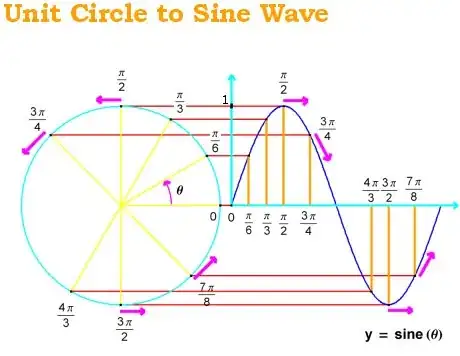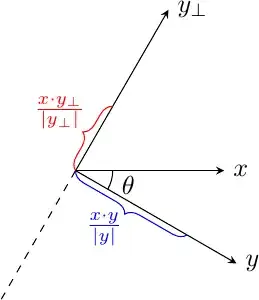In actuality, the best way to think of this is to think of angles traditionally, as a pair of rays sharing a common vertex. We can form an equivalence relation on angles, by saying that they are equivalent if there is a direct isometry between them. Then, we can partition all the possible angles in $\mathbb{R}^2$ into the equivalence classes, and the class of equivalence classes is a set, so it can be totally ordered. With this total ordering, the set of equivalence classes, as defined above, is order-isomorphic to the interval of real numbers $(-p,p]$ for some real number $p.$ The idea is that for each equivlance class, the real number assigned is a quantitative measure of the angles in the equivalence class. All angles in the same equivalence class have the same measure. Typically, $p$ is chosen to be equal to $\pi,$ but in actuality, $p$ is an arbitrary positive real number. A choice of $\pi$ amounts simply to a choice of half-period for the sinusoidal functions parametrizing the unit circle, with the parametrization corresponding directly to the interval $(-p,p].$
For a given choice of $p,$ the arclength of an arc corresponding to an angle measuring $s,$ where $s\in(-p,p],$ is equal to $\frac{\pi}{p}s.$ This makes the choice $p=\pi$ the most natural, and this is why people often say that doing calculus requires using radians. This is because calculus is most natural when the sinusoidal functions are chosen such that their half-period $p$ is $\pi.$ To demonstrate this point, consider the parametrization $(x(t),y(t)),$ where $x,y:(-p,p]\to[-1,1],$ such that $x$ is even, $y$ is odd, $x,y$ are continuous, and the functions satisfy the joint equation $x(t)^2+y(t)^2=1,$ and the boundary conditions $x(0)=1,$ $x(p)=-1,$ $y(0)=y(p)=0.$ This uniquely defines the sinusoidal functions $x$ and $y.$ The key idea to do calculus is the limit $$\lim_{t\to0}\frac{y(t)}{t}.$$ It can be proven, from elementary geometry, or using the unit circle parametrization, that $$x(u+v)=x(u)x(v)-y(u)y(v)$$ and $$y(u+v)=y(u)x(v)+x(u)y(v).$$ Hence $$y'(t)=\lim_{\epsilon\to0}\frac{y(t+\epsilon)-y(t)}{\epsilon}=y(t)\lim_{\epsilon\to0}\frac{x(\epsilon)-1}{\epsilon}+x(t)\lim_{\epsilon\to0}\frac{y(\epsilon)}{\epsilon}$$ and $$x'(t)=\lim_{\epsilon\to0}\frac{x(t+\epsilon)-x(t)}{\epsilon}=x(t)\lim_{\epsilon\to0}\frac{x(\epsilon)-1}{\epsilon}-y(t)\lim_{\epsilon\to0}\frac{y(\epsilon)}{\epsilon}.$$ Notice that $$\lim_{\epsilon\to0}\frac{x(\epsilon)-1}{\epsilon}=\lim_{\epsilon\to0}\frac{x(\epsilon)^2-1}{\epsilon[x(\epsilon)+1]}=-\lim_{\epsilon\to0}\frac{y(\epsilon)^2}{\epsilon[x(\epsilon)+1]},$$ and assuming $$\lim_{\epsilon\to0}\frac{y(\epsilon)}{\epsilon}$$ exists, we can safely say $$-\lim_{\epsilon\to0}\frac{y(\epsilon)^2}{\epsilon[x(\epsilon)+1]}=-\lim_{\epsilon\to0}\frac{y(\epsilon)}{x(\epsilon)+1}\lim_{\epsilon\to0}\frac{y(\epsilon)}{\epsilon}=0.$$ As for $$\lim_{\epsilon\to0}\frac{y(\epsilon)}{\epsilon},$$ we know, from the parametrization of the unit circle, that $$y(t)\leq\frac{\pi}{p}t\leq\frac{y(t)}{x(t)}$$ for $0\lt{t}\lt\frac{p}2,$ and $$y(t)\geq\frac{\pi}{p}t\geq\frac{y(t)}{x(t)}$$ for $0\gt{t}\gt-\frac{p}2.$ Dividing by $y(t)$ gives that $$1\leq\frac{\pi}{p}\frac{t}{y(t)}\leq\frac1{x(t)}$$ for $0\lt{t}\lt\left|\frac{p}2\right|.$ Therefore, $$x(t)\leq\frac{p}{\pi}\frac{y(t)}{t}\leq1,$$ hence $$\lim_{t\to0}x(t)=1\leq\frac{p}{\pi}\lim_{t\to0}\frac{y(t)}{t}\leq1.$$ This means $$\frac{p}{\pi}\lim_{t\to0}\frac{y(t)}{t}=1$$ or $$\lim_{t\to0}\frac{y(t)}{t}=\frac{\pi}{p}.$$ This gives us $$y'(t)=\frac{\pi}{p}$$ and $$x'(t)=-\frac{\pi}{p}y(t).$$ This is what connects the trigonometric definition of sine and cosine to their derivative definitions.
However, I prefer defining the trigonometric functions in terms of the inverse elliptic integrals instead, and this is more, natural, and it avoids making direct reference to $\pi.$ The elliptic integrals are covered by this article https://en.wikipedia.org/wiki/Elliptic_integral and the definition that I give of the arcsin is that of $$\arcsin(x):=E(x;0).$$ This relates it naturally to the arclength of an arc in a circle, and it also analogizes it with the definition of the natural logarithm as that of an area enclosed by a hyperbola.

